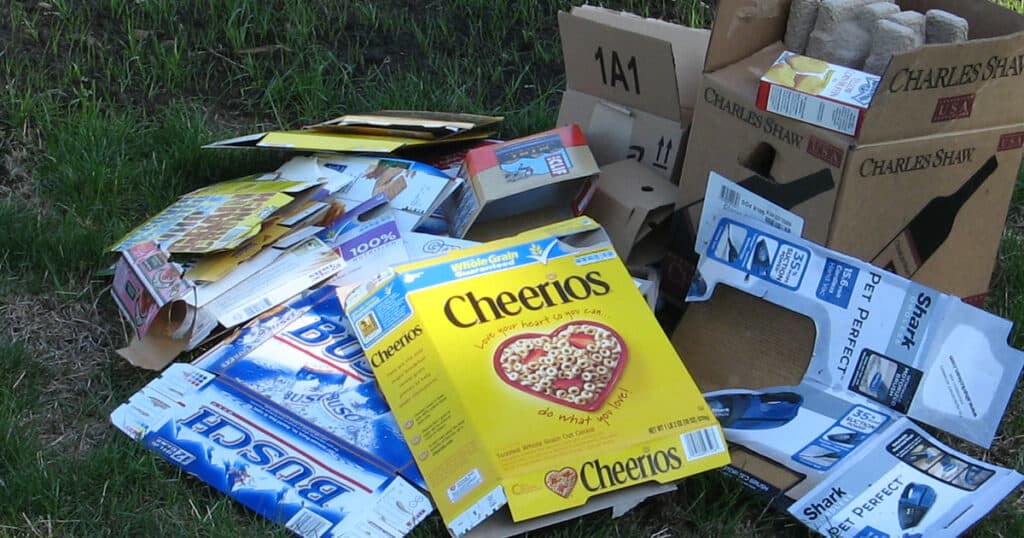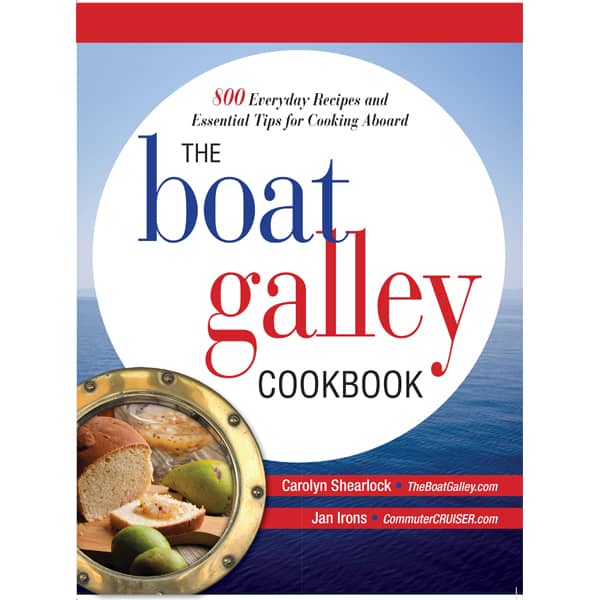A little over a week ago, a reader named MaryJo left the following comment on the article about “Avoiding Critters:”
“I’m confused about the whole cardboard thing. Everybody says “don’t bring cardboard on the boat,” but lots of things, like facial tissues and boxed wine come in cardboard. I can’t take those items out of their boxes. Please clarify. Thanks!”
I wrote her a few lines about getting rid of as much cardboard as possible, but then I found myself thinking about her question more and more. I realized that this had been one of my big questions when we first moved aboard Que Tal, and that I hadn’t found many answers and had just sort of fumbled my way along.
So, after making a big trip to the grocery, I made a list as I unloaded my purchases. How exactly did I get rid of almost all of the cardboard?
I’ll be honest — there are a few bits of cardboard that still make their way aboard, but I get rid of an awful lot of it!
- Little bottles in boxes: Things like vitamins, vanilla extract and so on are pretty easy — just take the little bottle or jar out of the box it came in.
- Blister packs: These seem easy — just take the item out of the package. BUT be sure to check if you need directions off the box (with small tubes, you often can’t read the directions on the tube) and either copy them down or cut them out and keep them. Depending on the item, we may tape the instructions to the item or put both the item and directions into a small resealable plastic bag.
- Hygiene products: A number of these come in boxes. You’re actually a lot better off to store them in resealable plastic bags to keep moisture (drips or leaks in particular) from getting to your supply. But I’d usually just take the box on the boat (for modesty reasons), transfer the contents to bags, then quickly get the boxes back off the boat.
- Pet food (in bags or boxes): I take the box or bag on board and transfer the contents to a good plastic container with a locking lid and get rid of the bag or box immediately. Read more about storing pet food.
- Soda, beer and other canned drinks in cases: I get rid of any box and just put the cans in bags to carry aboard the boat.
- Wine: If it’s in a case, remove the bottles and leave the cardboard in the trash ashore. For boxed wine that has a “plastic bag” bladder inside a box, I remove the bladder from the box and leave the box ashore (you can tell this type of box/bladder usually by the fact that it has a fancy push-button pouring mechanism). You can put the bladder(s) in a solid plastic storage bin to keep them from wearing a hole, and it’s really not that hard to pour a glass from one (also read a great idea from a reader on how to easily make a plastic wine box). If you buy several different varieties of wine — other than just one red and one white — be sure to use a permanent marker to label them.
- Tetra Paks: Tetra Paks are what we think of as “juice boxes” although lots of other things come in them — boxed milk, wine, even some veggies and fruits (instead of cans). Tetra Paks are specifically designed for long term storage of the contents and you shouldn’t try to repackage the item.
- Trash bags and plastic bags: These often come in a roll inside a cardboard box. I take the roll out and put it in a plastic grocery bag or other container and throw the cardboard away before it even gets on the boat. See more about this.
- Aluminum foil, wax paper: I’ve never found a good alternative to just leaving these in their boxes.
- Toilet paper and paper towels: Yes, there’s a cardboard tube in the center. No, I’ve never figured out how to avoid it. The best I can suggest is to check various brands and choose the rolls with the most sheets. This will save a lot of storage space, too, as some brands of toilet paper are extremely loosely rolled in foreign countries. I’ve seen some with only 60 sheets per roll at the same time I’ve bought rolls with 500 sheets! As a side note, we tended to use a few pieces of TP as a replacement for Kleenex, so we didn’t have the boxes on the boat.
- Rice, Pasta and Couscous: These often come in boxes. I take them on board in the box, and immediately transfer them to a plastic storage container and cut the directions out of the box and tape them to the container. Then the box gets taken ashore immediately.
- Cereal: Most cereal comes in a plastic bag inside a box and I pull the bag out of the box and leave the box ashore. Sometimes, you can buy cereal that’s just in a resealable plastic bag, which eliminates the box problem and is often cheaper.
- Crackers: Most boxes have plastic bags inside and I take the bag and leave the box. With both cereal and crackers, I put a bunch of the bags together in one storage bin in a location where heavy stuff can’t fall on top of it. For crackers that come in waxed paper sleeves, I put several together in one resealable plastic bag or they’ll quickly pick up moisture in the air and get stale.
- Box mixes. Again, most have liners. I either write the directions on the inner bag or cut them out of the box, then put the liner and instructions inside a resealable plastic bag (along with a bay leaf as protection against weevils). Be sure to label the contents!
In addition to all the galley stuff, also beware of cardboard from other sources and try to reduce as much as you can. Things like spare or replacement parts, tools, galley equipment, and gadgets all tend to come with cardboard. Sometimes, though, we just didn’t want to get rid of it: either we needed to keep the packaging in case we needed to return the item, or in some cases, the box and packaging were really the best way to store spare parts.
In those cases, if the item was small enough, we put the whole thing in a resealable plastic bag (or vacuum sealed it), figuring that if there was no fresh air or food, any critters in the cardboard would soon die. Some larger items, like our spare bilge pump, we couldn’t do anything about . . . we just accepted the fact that we had some cardboard.
Even though it’s not “cardboard” per se, we also learned to watch out for books from book exchanges that didn’t have a lot of turnover. More than once, they were serving as homes to numerous bugs. We learned to put them in a plastic bag and give them a squirt of bug spray, then leave them in the bag in the cockpit overnight. With more and more boats carrying their books digitally — on a Kindle or iPad, for example — this might be less of a problem for some (those with e-readers) and more of a problem for others (as print books sit longer in exchanges with fewer people reading them).

Carolyn Shearlock has lived aboard full-time for 17 years, splitting her time between a Tayana 37 monohull and a Gemini 105 catamaran. She’s cruised over 14,000 miles, from Pacific Mexico and Central America to Florida and the Bahamas, gaining firsthand experience with the joys and challenges of life on the water.
Through The Boat Galley, Carolyn has helped thousands of people explore, prepare for, and enjoy life afloat. She shares her expertise as an instructor at Cruisers University, in leading boating publications, and through her bestselling book, The Boat Galley Cookbook. She is passionate about helping others embark on their liveaboard journey—making life on the water simpler, safer, and more enjoyable.
Simplify meal prep on board with proven strategies for provisioning, maximizing fridge space, and cooking delicious meals aboard your boat.










Donna says
I am storing my foil and plastic wrap in a plastic holder purchased online. It works great and no cardboard issue. They are sold by one of the online shopping sites under the name Wrap Master and Foil Master. We are not onboard fulltime yet…but working on it. Love, love, love your tips and tricks!
Andrea says
First off, let me say thank you and I’m so excited to have found your site. It’s quite thorough! Thank you.
Next, on the cardboard, I have to say I didn’t know that bug infestation from cardboard was such a problem, but I can recall seeing bugs on cardboard boxes in stores before, so I understand what you’re saying. However, I’m in the process of installing a little Dickinson solid fuel stove, and I was just thinking how nice it would be to use my cardboard as a starter to the fire. Up until now, I’ve been putting cardboard boxes in a confined plastic container where they stay until I take the recycling in. But of course, your thoughts on cardboard or making me wonder. I look forward to more perusing of your site!
Susan says
I know you have to worry about bugs in the tropics, but how about in the Pacific Northwest?
Carolyn Shearlock says
I’ve never lived/cruised there, so don’t have first-hand experience. I’ve heard that spiders can be bad there . . . anyone from the area care to add more?
Thanks! -Carolyn
Steve says
Take a photo of those instructions instead of cutting them out of the box. Works great from a tablet (I.e. iPad)
Kimberly says
I have been cruising the Pacific Northwest and Canadian waters for over a decade and have had no problems with any bug infestations (knock on wood!). As such, I do not spend much time worrying about eliminating cardboard other than the garbage aspect of it as the more remote cruising areas do not have a capacity for our garbage.
Judy Thompson says
I have heard that you can zap things in the microwave and it will kill bugs and their eggs. Does anyone know if this is actually true and if so how long do you need to put them in for?
Helen Marie Stanfield Bell says
One cruiser said they totally removed the cardboard rolls from toilet paper and paper towels…they said they store flatter too
The Boat Galley says
About a month ago, I saw a couple ads for Charmin — they now are making TP rolls without a cardboard core. Haven’t seen it in a store though!
S/V Dos Libras says
It really is amazing how much we drag home!
Annual Salvador Rally says
Busch Beer–haven’t seen tat around for a long time
The Boat Galley says
Oh, it’s alive and well . . . it’s our friends’ favorite beer.
Lynn Kaak says
The plastic egg crates that are found in camping supplies are worth more than their weight in gold! No cardboard on board, and they stay safer.
The Boat Galley says
Actually, I like the Lock & Lock ones better than the Coleman ones you find in the camping department. The Coleman ones pop open WAY too easily.
Lynn Kaak says
Haven’t seen the look and lock ones. But for 11 years, the Coleman ones have worked reasonably well for us, just wish they could take XL eggs!
Lynn Kaak says
I would also argue about worrying about the cardboard in TP or paper towels, or any paper products. The critters can live in the layers of paper, too!
The Boat Galley says
True, but I’m not living without TP. I know some cultures do, but not mine.
Becky Groston says
We’ve sailed and now “power ” in the NW for 40 years. No worries here about bugs in cardboard. (‘Skits are the major pest!) I have a large enough boat now that I can flatten my cardboard and stick it between stored goods for extra cusioning until I get to a recycling bin. I still transfer as much as I can to plastic bags before a cruise. I keep dog kibble in repurposed nut plastic “jars.” Keeps the rest fresher. I re -use zip -lock bags at the sink for bits of “organic garbage” to cut the smell before putting them in the garbage bag too.
Linda Kayser says
What is a skit?
Carolyn Shearlock says
I think she’s referring to mosquitoes being the major pest they encounter.
Ricardo Druillet says
Check this out Helena Gurascier
Jessica Heinicke says
Do I need to get rid of cardboard I’ve had on the boat for years? I know bugs/bug eggs can be in the cardboard you buy in the tropics. Can I get an infestation in the decorative boxes that I bought in the US and I know are bug-free?
The Boat Galley says
They will hide in and under boxes . . . and the boxes also can trap moisture. I’d keep an eye on them at the very least.
Jessica Heinicke says
The Boat Galley Thanks! We have 10 months before we head for the tropics. I’ll keep an eye out for alternatives.
Anonymous says
Mandi Pi
Anonymous says
I just can’t believe that cardboard is actually that dirty and no one talks about it outside the sailing community 😂
Anonymous says
Ikr. Same here.
Dorinda Morpeth says
You can put just about anything in your deep freezer for several days. If you need to protect it from moisture put the item in a plastic bag than into the freezer. Leave in bag until you get the item on the boat.
Reggie says
We remove wine bladders from the boxes and store just the bladders. some ore stored in our oven since it rarely gets used for baking, and, as my wife reminds me, notin’ says lovin’ like somethin’ from the oven!
Natalie says
Why not spray the cardboard you have to retain with bug spray? And I think I’d take a lot of my containers off the boat and decant what I could ashore instead if bringing the cardboard on the boat in the first place. That being said, we’re moored in a Marina and the bane of my life is spiders … some if which are rather large. I need a sure fire way to convince thembour boat is not a safe refuge!
Carolyn Shearlock says
Yes, removing food from cardboard before you bring it aboard is one of the most-used techniques for keeping cardboard off the boat. But since the few things that I do have to keep cardboard for are either foods or things that touch food, not sure I want to spray it with bug spray!
Have you seen this post about getting rid of spiders? Getting Rid of Spiders
c. says
Tip for keeping instructions:
Take clear pictures of the original packaging, the instructions, and note on either plastic bag or storage box there is a picture. Store it all on a handy thumb drive. Most people keep a running list/database list of items, whatever they may be (tools, parts, household stuff). You often have to check a laptop to remember where you’ve stored the things you’re looking for anyway. (With so many cubbyholes, I know I do.) Print out the instructions if necessary. Or, store packaging/complicated instructions with items grouped in large plastic bags.
David W Wright says
Flat cardboard like the kind found in cereal & tissue boxes poses no more of a problem than sta5tionary or notepad paper. Corregated cardboard like that found in shipping boxes is what you should not bring aboard. The pockets in the corregations make perfect nesting places for all kinds of pests & their eggs.
Dinah says
I agree. Corrugated cardboard is like a roach motel
Dave Skolnick (S/V Auspicious) says
It is my understanding that there are two issues with cardboard: 1. is insect eggs which is mostly a problem with corrugated boxes and things like book spines; 2. is that many insects are happy to eat and thrive on the glue that holds boxes together.
My words for Carolyn’s guidance, which I support, is do the best you can then try a little harder but don’t make yourself crazy. In my case, cardboard doesn’t make it out of the dinghy or dock cart and certainly not below, but I’m not going to make myself nuts over toilet paper cardboard rolls, paper towel cardboard rolls, or facial tissue boxes.
On the last item, I tend toward the cube boxes of facial tissues and save the empties to use as small trash bins around the boat – one in each cabin, one in the head (instead of a can), and one at the nav station (my “office”).